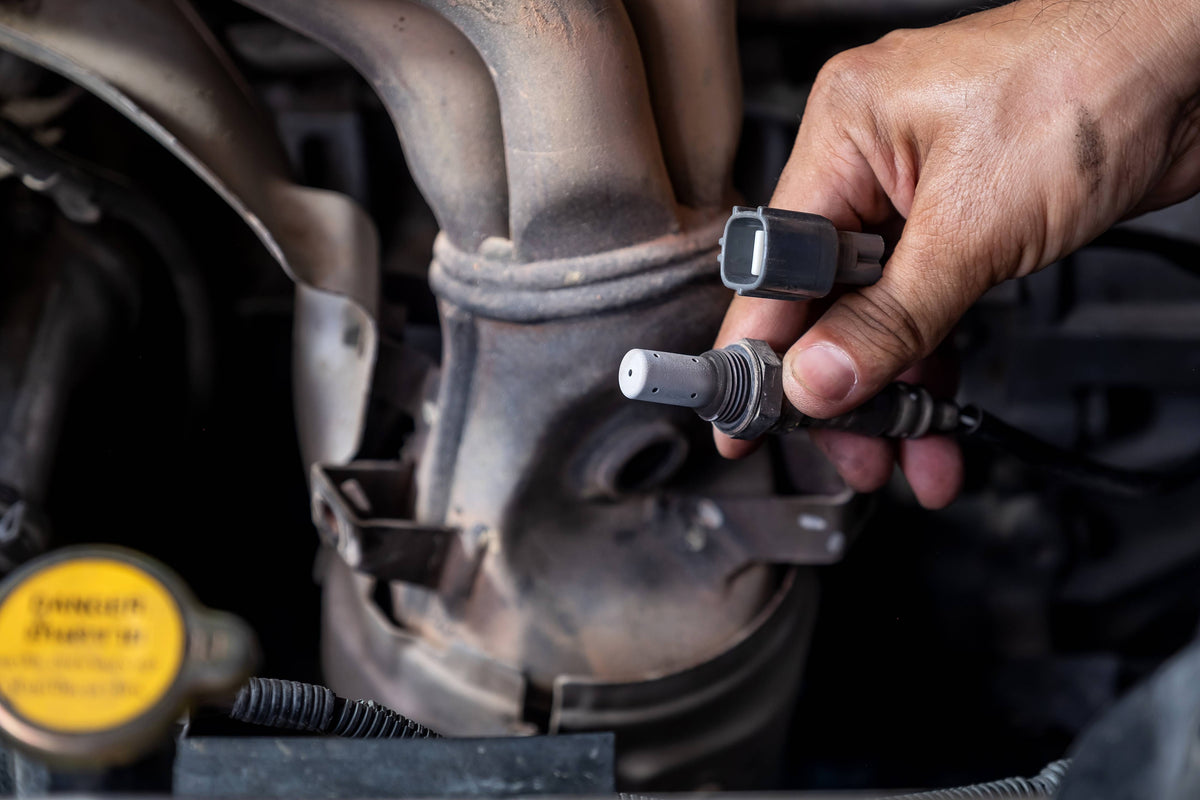
Oxygen Sensors Explained: Purpose, Function & Troubleshooting
|
|
Time to read 4 min
|
|
Time to read 4 min
Oxygen sensors are a key component of modern engine control systems. As the name suggests, oxygen sensors measure the amount of oxygen in the exhaust.
Though small in size, O2 sensors play a big role in emissions control, fuel efficiency, and engine performance. In this post, we'll take a closer look at what oxygen sensors do, how they work, and troubleshooting issues.
💡 Did you know
Oxygen sensors must reach over 300°C to function correctly. That’s why most are heated (heated oxygen sensors) to speed up warm-up time and enable closed-loop operation quickly.
An oxygen sensor monitors the amount of oxygen present in the exhaust gases as they exit the combustion chamber. This data is critical for the engine control unit (ECU) to determine if the air-fuel ratio is too rich (too much fuel) or too lean (too much air).
There are usually two types of O2 sensors on modern vehicles:
Upstream sensors – Located before the catalytic converter, these help the ECU fine-tune the air-fuel mixture.
Downstream sensors – Located after the catalytic converter, these monitor the efficiency of the catalytic converter.
Oxygen sensors generate a voltage signal based on the air-fuel mixture:
Low voltage (~0.1V) = Lean (too much air)
High voltage (~0.9V) = Rich (too much fuel)
This signal is sent to the ECU (Engine Control Unit), which uses the data to adjust fuel delivery and keep the air-fuel ratio balanced - ideally at 14.7:1 (known as the stoichiometric ratio).
Check Engine Light (CEL)
Increased fuel consumption
Failed emissions test
Rough idle or hesitation
Sulfur (rotten egg) smell from exhaust
Poor acceleration
Narrowband O2 Sensors (1-4 wires) only detect a narrow air-fuel range, around 14.6-14.8:1. They're common in older cars and let the ECU know if the engine is running at the stoichiometric ratio.
However, narrowband oxygen sensors can’t measure richer or leaner mixtures accurately.
Wideband O2 Sensors (usually 5-6 wires) can measure a broad range of air-fuel ratios accurately.
They require a controller (either external or built-in to the ECU) and typically send a 0-5V signal or CAN data to the ECU for precise fuel tuning, especially useful in performance and tuning applications.
A faulty oxygen sensor can cause poor fuel economy, rough idling, excessive emissions, and check engine lights. Here's a basic diagnostic process:
Use a scan tool to retrieve stored fault codes.
View the conditions when the fault occurred (engine load, RPM, temperature, etc.). This can help rule out intermittent issues.
Use a scan tool to view live oxygen sensor voltage:
Check for:
Damaged wiring or connectors
Exhaust leaks near the sensor
Contamination (oil, coolant, or carbon deposits).
Use a multimeter to test resistance across the heater pins. You'll need to compare this value to the manufacturer's specifications.
Back-probe into the signal wire. Don’t unplug the sensor from the ECU.
Warm up the engine. O2 sensors only work when at operating temperature.
Connect to the sensor output and run the engine at ~2000 RPM .
A healthy sensor will rapidly switch between ~0.1V and 0.9V (lean to rich). The lean to rich time should be around 300 milliseconds.
If the voltage is slow or flat, the sensor is likely faulty and should be replaced.
Testing regularly helps maintain fuel economy and reduces emissions.
Upstream Sensor (Pre-Cat):
O2 sensor voltage should rapidly switch between ~0.1V and 0.9V at steady throttle. This shows the ECU is adjusting the air-fuel mix in real time.
Downstream Sensor (Post-Cat):
Voltage should be relatively steady, around 0.4–0.6V. Little movement means the catalytic converter is working properly.
If the downstream sensor mimics the upstream fluctuations, the catalytic converter may be underperforming.
Here’s a list of frequently encountered O2 sensor-related fault codes:
Code |
Description |
|---|---|
| P0130 | O2 Sensor Circuit (Bank 1, Sensor 1) |
| P0133 | O2 Sensor Circuit Slow Response (Bank 1, Sensor 1) |
| P0135 | O2 Sensor Heater Circuit Malfunction (Bank 1, Sensor 1) |
| P0140 | O2 Sensor No Activity Detected (Bank 1, Sensor 2) |
| P0141 | O2 Sensor Heater Circuit Malfunction (Bank 1, Sensor 2) |
| P0150 | O2 Sensor Circuit (Bank 2, Sensor 1) |
| P0155 | O2 Sensor Heater Circuit Malfunction (Bank 2, Sensor 1) |
| P0161 | O2 Sensor Heater Circuit Malfunction (Bank 2, Sensor 2) |
| P0420 | Catalyst System Efficiency Below Threshold (Bank 1) |
| P0430 | Catalyst System Efficiency Below Threshold (Bank 2) |
Note: P0420 and P0430 often result from degraded catalytic converters but can also be caused by faulty downstream sensors. Fault codes are an indication of the cause but not a complete diagnosis.
Check fuel trims alongside oxygen sensor data for a broader picture.
A failing sensor can mimic other issues like vacuum leaks or injector problems. Avoid replacing an oxygen sensor based on a code alone.
Replace sensors with OEM or high-quality aftermarket parts to avoid premature failure or abnormal readings.
O2 Sensors are small yet essential components for efficient and clean engine operation. Understanding their role, how they function and how to diagnose them can save time and prevent unnecessary parts replacement.
Generally, no. Oxygen sensors are considered non-serviceable components. Cleaning them rarely restores proper function, and harsh chemicals can damage the sensing element. Replacement is the recommended solution.
Scan tool with live data or graphing
Digital multimeter (for heater circuit and voltage checks)
Infrared thermometer (to check exhaust temp pre/post-cat)
Oscilloscope (to check signal output).
Oxygen sensors sit in the exhaust and measure how much oxygen is left in the exhaust gases after combustion.
Oil or coolant leaks entering the exhaust
Using leaded fuel (rare but still happens with classic cars)
Silicone-based gasket sealants
Excessive carbon build-up
Overheating due to a rich mixture or misfire
